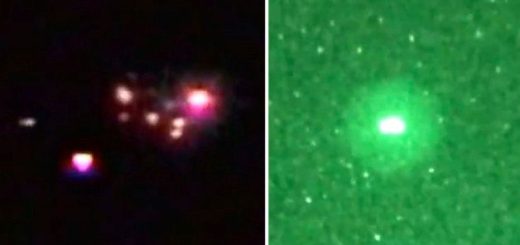Peculiar “Nearly Naked” Supermassive Black Hole Fleeing From Larger Galaxy – Discovered

– Astronomers from the National Radio Astronomy Observatory discovered the shredded remains of a galaxy that passed through a larger galaxy, leaving only the smaller galaxy’s nearly-naked supermassive black hole to emerge and speed away at more than 2,000 miles per second.
The fascinating discovery was made when astronomers used National Science Foundation’s Very Long Baseline Array (VLBA) known to have super-sharp radio vision, to detect supermassive black holes, millions or billions of times more massive than the Sun, that are not at the centers of galaxies.
“We were looking for orbiting pairs of supermassive black holes, with one offset from the center of a galaxy, as telltale evidence of a previous galaxy merger. Instead, we found this black hole fleeing from the larger galaxy and leaving a trail of debris behind it,” U.S. National Radio Astronomy Observatory’s James Condon — the lead author of a study detailing the observations — said in a statement released by NRAO.
“We’ve not seen anything like this before.”
See also:
Wandering Black Hole Found 4.5 Billion Light Years From Earth
Monster Black Holes 10 Billion Times Greater Than The Sun
Super Massive Black Holes Lurking In The Hearts Of Galaxies
More Astronomy News
Located in a galaxy cluster called ZwCl 8193, approximately two billion light years away, the object called B3 1715+425, was probably formed when a large galaxy collided with a smaller one millions of years ago. This celestial event stripped the latter of nearly all its stars and gas.
Astronomer Jim Condon explains the discovery and significance of B3 1715+425, a “nearly naked” supermassive black hole.
What remains is its black hole and a small galactic remnant only about 3,000 light-years across. (Remember: our Milky Way Galaxy is approximately 100,000 light-years across.)
Additionally, this object is speeding away from the core of a much larger galaxy, leaving a wake of ionized gas behind it.
The speeding object will lose more and more mass and eventually cease forming new stars.
With the VLBA, astronomers will observe and discover many more objects similar to the fascinating and peculiar B3 1714+425.



 Creators of mankind
Creators of mankind Description of “Tall white aliens”
Description of “Tall white aliens” Where they came from?
Where they came from? About hostile civilizations
About hostile civilizations The war for the Earth
The war for the Earth “Tall white aliens” about eternal life
“Tall white aliens” about eternal life Video: “Nordic aliens”
Video: “Nordic aliens” Aliens
Aliens Alien encounters
Alien encounters The aliens base
The aliens base UFO
UFO Technology UFO
Technology UFO Underground civilization
Underground civilization Ancient alien artifacts
Ancient alien artifacts Military and UFO
Military and UFO Mysteries and hypotheses
Mysteries and hypotheses Scientific facts
Scientific facts


















